The Effect of Rare-Earth Elements on the Morphological Aspect of Borate and Electrocatalytic Sensing of Biological Compounds
Abstract
:1. Introduction
2. Materials and Methods
2.1. Chemicals and Instrumentation
2.2. Synthesis of Rare-Earth Borates
2.3. Fabrication of Electrodes
2.4. Preparation of Solutions
3. Results
3.1. Investigation of Borates Structure
3.2. Conductivity and Electrochemical Activity in Redox Probe
- ip—Peak current in amps;
- n—Number of electrons participating in each redox action;
- A—Electrochemical active surface of the electrode in cm2;
- C—Concentration in mols per mL;
- D—Diffusion coefficient in cm2/s;
- v—Scan rate in V/s.
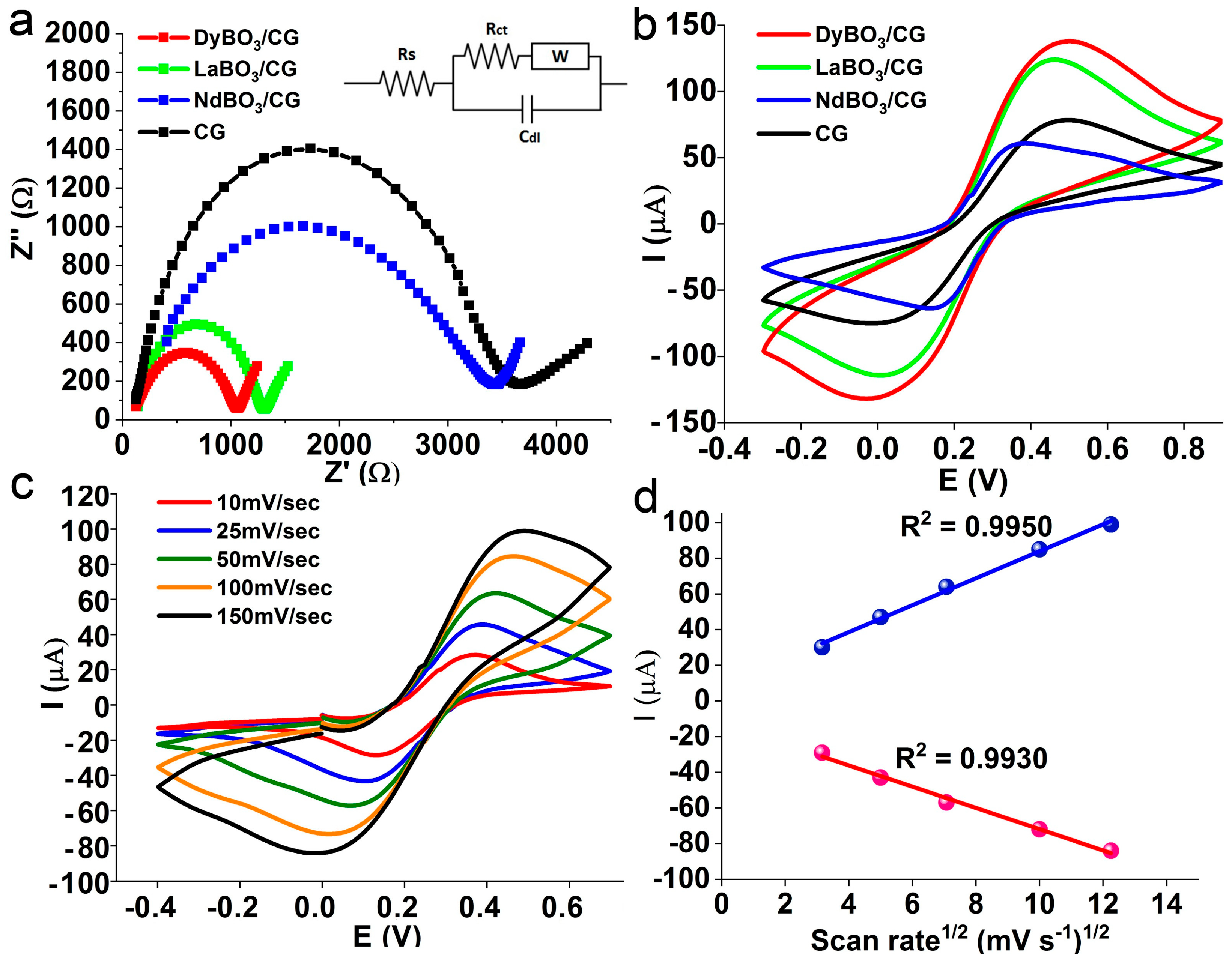
3.3. Electrochemical Evaluation of Pyridoxine
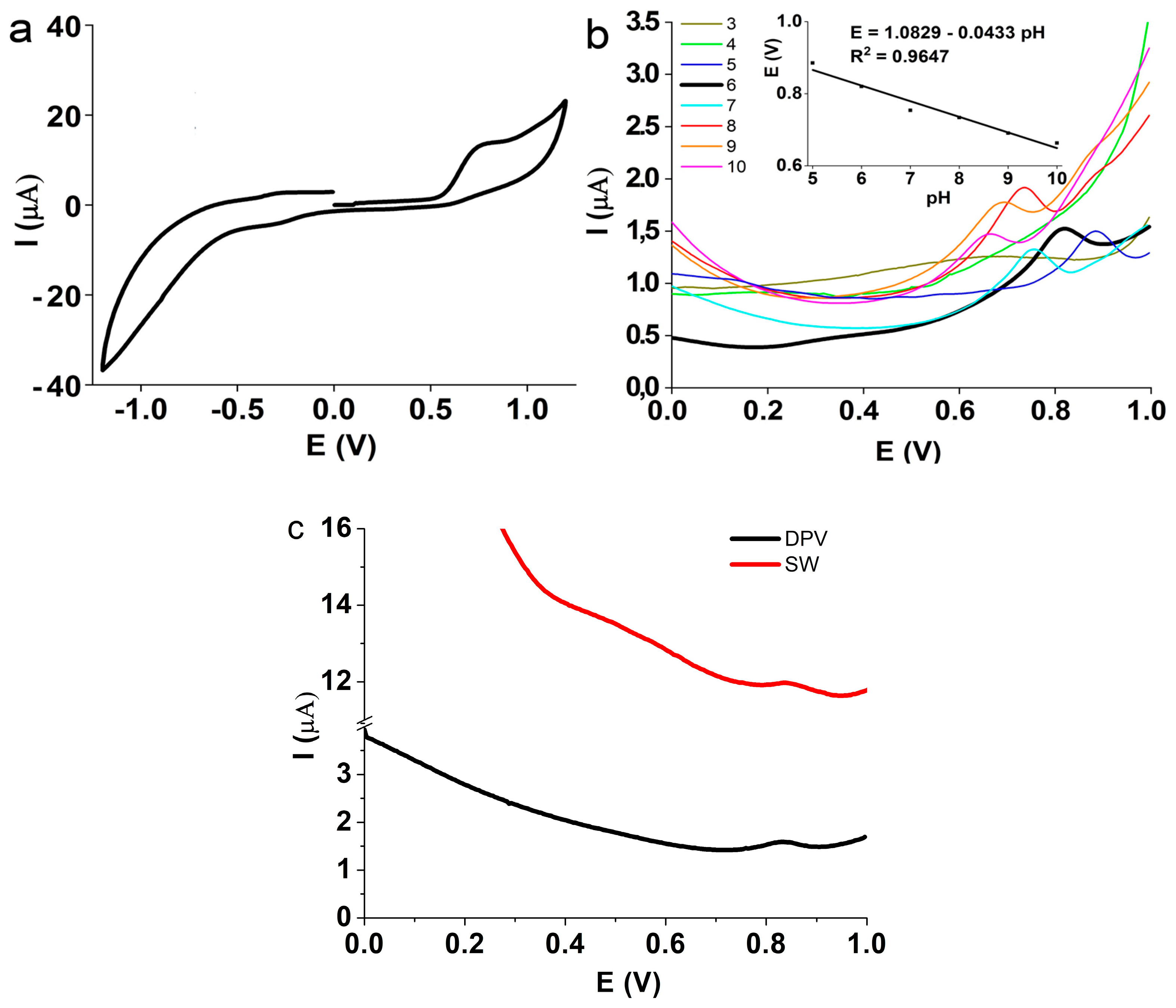
- d—Standard deviation of blank signal (y-intercept of the calibration graph);
- s—Slope of the calibration graph.
3.4. Reproducibility Experiment
3.5. Experiment with Interfering Compounds
4. Conclusions
Author Contributions
Funding
Institutional Review Board Statement
Informed Consent Statement
Data Availability Statement
Conflicts of Interest
References
- Preedy, V.R. Handbook of Diet, Nutrition and the Skin; Wageningen Academic Publishers: Wageningen, The Netherlands, 2012. [Google Scholar]
- Qu, W.; Wu, K.; Hu, S. Voltammetric determination of pyridoxine (Vitamin B6) by use of a chemically-modified glassy carbon electrode. J. Pharm. Biomed. Anal. 2004, 36, 631–635. [Google Scholar] [CrossRef] [PubMed]
- Merrill, A.H.; Henderson, J.M. Diseases associated with defects in vitamin B6 metabolism or utilization. Annu. Rev. Nutr. 1987, 7, 137–156. [Google Scholar] [CrossRef] [PubMed]
- Slominski, A.; Wortsman, J. Neuroendocrinology of the skin. Endocr. Rev. 2000, 21, 457–487. [Google Scholar] [CrossRef]
- Kumrungsee, T.; Zhang, P.; Chartkul, M.; Yanaka, N.; Kato, N. Potential Role of Vitamin B6 in Ameliorating the Severity of COVID-19 and Its Complications. Front. Nutr. 2020, 7, 562051. [Google Scholar] [CrossRef] [PubMed]
- Friso, S.; Jacques, P.F.; Wilson PW, F.; Rosenberg, I.H.; Selhub, J. Low circulating vitamin B6 is associated with elevation of the inflammation marker C-reactive protein independently of plasma homocysteine levels. Circulation 2001, 103, 2788–2791. [Google Scholar] [CrossRef] [PubMed]
- Clayton, P.T. B6-responsive disorders: A model of vitamin dependency. J. Inherit. Metab. Dis. 2006, 29, 317–326. [Google Scholar] [CrossRef] [PubMed]
- Zhang, S.M.; Willett, W.C.; Selhub, J.; Hunter, D.J.; Giovannucci, E.L.; Holmes, M.D.; Colditz, G.A.; Hankinson, S.E. Plasma Folate, Vitamin B6, Vitamin B12, Homocysteine, and Risk of Breast Cancer. JNCI J. Natl. Cancer Inst. 2003, 95, 373–380. [Google Scholar] [CrossRef]
- Weinstein, S.J.; Hartman, T.J.; Stolzenberg-Solomon, R.; Pietinen, P.; Barrett, M.J.; Taylor, P.R.; Virtamo, J.; Albanes, D. Null association between prostate cancer and serum folate, vitamin B6, vitamin B12, and homocysteine. Cancer Epidemiol. Biomark. Prev. 2003, 12, 1271–1272. [Google Scholar]
- Larsson, S.C.; Orsini NLarsson, S.C.; Orsini, N.; Wolk, A. Vitamin B6 and risk of colorectal cancer: A meta-analysis of prospective studies. JAMA 2015, 303, 1077–1083. [Google Scholar] [CrossRef]
- Tanoue, L.T. Serum B Vitamin Levels and Risk of Lung Cancer. Yearb. Pulm. Dis. 2012, 2012, 70–72. [Google Scholar] [CrossRef]
- Bilski, P.; Li, M.Y.; Ehrenshaft, M.; Daub, M.E.; Chignell, C.F. Symposium-in-Print Vitamin B6 (Pyridoxine) and Its Derivatives Are Efficient Singlet Oxygen Quenchers and Potential Fungal Antioxidants. Photochem. Photobiol. 2000, 71, 129–134. [Google Scholar] [CrossRef] [PubMed]
- Kannan, K.; Jain, S.K. Effect of vitamin B6 on oxygen radicals, mitochondrial membrane potential, and lipid peroxidation in H2O2-treated U937 monocytes. Free Radic. Biol. Med. 2004, 36, 423–428. [Google Scholar] [CrossRef]
- Rejithamol, R.; Beena, S. Electrochemical quantification of pyridoxine (VB6) in human blood from other water-soluble vitamins. Chem. Pap. 2020, 74, 2011–2020. [Google Scholar] [CrossRef]
- Skarupski, K.A.; Tangney, C.; Li, H.; Ouyang, B.; Evans, D.A.; Morris, M.C. Longitudinal association of vitamin B-6, folate, and vitamin B-12 with depressive symptoms among older adults over time. Am. J. Clin. Nutr. 2010, 92, 330–335. [Google Scholar] [CrossRef] [PubMed]
- Ayora Cañada, M.J.; Pascual Reguera, M.I.; Molina Díaz, A. Selective determination of pyridoxine in the presence of hydrosoluble vitamins using a continuous-flow solid phase sensing device with UV detection. Int. J. Pharm. 2000, 202, 113–120. [Google Scholar] [CrossRef] [PubMed]
- Jiménez-Prieto, R.; Silva, M.; Pérez-Bendito, D. Analytical assessment of the oscillating chemical reactions by use chemiluminescence detection. Talanta 1997, 44, 1463–1472. [Google Scholar] [CrossRef]
- Asadpour-Zeynali, K.; Bastami, M. Net analyte signal standard addition method (NASSAM) as a novel spectrofluorimetric and spectrophotometric technique for simultaneous determination, application to assay of melatonin and pyridoxine. Spectrochim. Acta Part A Mol. Biomol. Spectrosc. 2010, 75, 589–597. [Google Scholar] [CrossRef]
- Engel, R.; Stefanovits-Bányai, É.; Abrankó, L. LC simultaneous determination of the free forms of B group vitamins and vitamin C in various fortified food products. Chromatographia 2010, 71, 1069–1074. [Google Scholar] [CrossRef]
- Markopoulou, C.K.; Kagkadis, K.A.; Koundourellis, J.E. An optimized method for the simultaneous determination of vitamins B1, B6, B12, in multivitamin tablets by high performance liquid chromatography. J. Pharm. Biomed. Anal. 2002, 30, 1403–1410. [Google Scholar] [CrossRef]
- Santhy, A.; Saraswathyamma, B.; Parvathy Krishnan, A.; Luscious, L. Nanomaterials incorporated electrochemical sensors for the monitoring of pyridoxine: A mini review. Mater. Today Proc. 2020, 46, 2998–3004. [Google Scholar] [CrossRef]
- Brunetti, B.; Desimoni, E. Voltammetric determination of vitamin B6 in food samples and dietary supplements. J. Food Compos. Anal. 2014, 33, 155–160. [Google Scholar] [CrossRef]
- Atta, N.F.; Galal, A.; El-Ads, E.H.; El-Gohary, A.R.M. Effective and Facile Determination of Vitamin B6 in Human Serum with CuO Nanoparticles/Ionic Liquid Crystal Carbon Based Sensor. J. Electrochem. Soc. 2017, 164, B730–B738. [Google Scholar] [CrossRef]
- Manoj, D.; Rajendran, S.; Qin, J.; Sundaravadivel, E.; Yola, M.L.; Atar, N.; Gracia, F.; Boukherroub, R.; Gracia-Pinilla, M.A.; Gupta, V.K. Heterostructures of mesoporous TiO2 and SnO2 nanocatalyst for improved electrochemical oxidation ability of vitamin B6 in pharmaceutical tablets. J. Colloid Interface Sci. 2019, 542, 45–53. [Google Scholar] [CrossRef] [PubMed]
- Porto, L.S.; Silva DN da Silva, M.C.; Pereira, A.C. Electrochemical Sensor Based on Multi-walled Carbon Nanotubes and Cobalt Phthalocyanine Composite for Pyridoxine Determination. Electroanalysis 2019, 31, 820–828. [Google Scholar] [CrossRef]
- Ojani, R.; Hamidi, P.; Raoof, J.B. Sensitive amperometric pyridoxine sensor based on self-assembled Prussian blue nanoparticle-modified poly(o-phenylenediamine)/glassy carbon electrode. Appl. Organomet. Chem. 2016, 30, 297–303. [Google Scholar] [CrossRef]
- Razmi, H.; Mohammad-Rezaei, R.; Heidari, H. Self-assembled prussian blue nanoparticles based electrochemical sensor for high sensitive determination of H2O2 in acidic media. Electroanalysis 2009, 21, 2355–2362. [Google Scholar] [CrossRef]
- Kanna Sharma, T.S.; Hwa, K.Y.; Santhan, A.; Ganguly, A. Synthesis of novel three-dimensional flower-like cerium vanadate anchored on graphitic carbon nitride as an efficient electrocatalyst for real-time monitoring of mesalazine in biological and water samples. Sens. Actuators B Chem. 2021, 331, 129413. [Google Scholar] [CrossRef]
- Kokulnathan, T.; Chen, S.M. Robust and selective electrochemical detection of antibiotic residues: The case of integrated lutetium vanadate/graphene sheets architectures. J. Hazard. Mater. 2020, 384, 121304. [Google Scholar] [CrossRef]
- Kokulnathan, T.; Chen, S.M. Rational Design for the Synthesis of Europium Vanadate-Encapsulated Graphene Oxide Nanocomposite: An Excellent and Efficient Catalyst for the Electrochemical Detection of Clioquinol. ACS Sustain. Chem. Eng. 2019, 7, 4136–4146. [Google Scholar] [CrossRef]
- Sari, S.; Senberber, F.T.; Yildirim, M.; Kipcak, A.S.; Yuksel, S.A.; Derun, E.M. Lanthanum borate synthesis via the solid-state method from a La2O3 precursor: Electrical and optical properties. Mater. Chem. Phys. 2017, 200, 196–203. [Google Scholar] [CrossRef]
- Kipçak, A.S. LOW Temperature Solid-State Synthesis and Characterization of LaBO3. Uludağ Univ. J. Fac. Eng. 2016, 21, 227–236. [Google Scholar] [CrossRef]
- Mueller-Bunz, H.; Nikelski, T.; Schleid, T. Single Crystals of the Neodymium(III) meta-Borate Nd(BO2)3 and ortho-Borate Nd[BO3]. B Chem. Sci. 2003, 58, 375–380. [Google Scholar] [CrossRef]
- Sasaki, S.; Masuno, A.; Ohara, K.; Yanaba, Y.; Inoue, H.; Watanabe, Y.; Kohara, S. Structural Origin of Additional Infrared Transparency and Enhanced Glass-Forming Ability in Rare-Earth-Rich Borate Glasses without B-O Networks. Inorg. Chem. 2020, 59, 13942–13951. [Google Scholar] [CrossRef] [PubMed]
- Seyyidoğlu, S. Synthesis and Characterization of Novel Rare Earth Phosphates and Rietveld Structural Analysis of Rare Earth Orthoborates. Ph.D. Thesis, Middle East Technical University, Ankara, Turkey, 2009. [Google Scholar]
- Wei, M.; Qiao, Y.; Zhao, H.; Liang, J.; Li, T.; Luo, Y.; Lu, S.; Shi, X.; Lu, W.; Sun, X. Electrochemical non-enzymatic glucose sensors: Recent progress and perspectives. Chem. Commun. 2020, 56, 14553–14569. [Google Scholar] [CrossRef]
- Zanello, P. Inorganic Electrochemistry. Theory, Practice and Application; Royal Society of Chemistry: London, UK, 2003. [Google Scholar]
- Habekost, A. Simulation and Fitting of Cyclic Voltammetry and Chronoamperometry Curves of Electrochemical Reactions with Different Mechanisms—A Didactic Perspectiv. World J. Chem. Educ. 2019, 7, 53–64. [Google Scholar] [CrossRef]
- Kuzmanović, D.; Khan, M.; Mehmeti, E.; Nazir, R.; Amaizah, N.R.R.; Stanković, D.M. Determination of pyridoxine (Vitamin B6) in pharmaceuticals and urine samples using unmodified boron-doped diamond electrode. Diam. Relat. Mater. 2016, 64, 184–189. [Google Scholar] [CrossRef]
- Moustafa, A.; El-Kamel, R.S.; Abdelgawad, S.; Fekry, A.M.; Shehata, M. Electrochemical determination of vitamin B6 (pyridoxine) by reformed carbon paste electrode with iron oxide nanoparticles. Ionics 2022, 28, 4471–4484. [Google Scholar] [CrossRef]
- Laborda, E.; González, J.; Molina, Á. Recent advances on the theory of pulse techniques: A mini review. Electrochem. Commun. 2014, 43, 25–30. [Google Scholar] [CrossRef]
- Macdougall, D.; Crummett, W.B. Guidelines for Data Acquisition and Data Quality Evaluation in Environmental Chemistry. Anal. Chem. 1980, 52, 2242–2249. [Google Scholar] [CrossRef]
- Manoj, D.; Rajendran, S.; Gracia, F.; Naushad, M.; Santhamoorthy, M.; Soto-Moscoso, M.; Gracia-Pinilla, M.A. Engineering ZnO nanocrystals anchored on mesoporous TiO2 for simultaneous detection of vitamins. Biochem. Eng. J. 2022, 186, 108585. [Google Scholar] [CrossRef]
- Pereira, D.F.; Santana, E.R.; Spinelli, A. Electrochemical paper-based analytical devices containing magnetite nanoparticles for the determination of vitamins B2 and B6. Microchem. J. 2022, 179, 107588. [Google Scholar] [CrossRef]
- Sonkar, P.K.; Ganesan, V.; Gupta, S.K.; Yadav, D.K.S.; Gupta, R.; Yadav, M. Highly dispersed multiwalled carbon nanotubes coupled manganese salen nanostructure for simultaneous electrochemical sensing of vitamin B2 and B6. J. Electroanal. Chem. 2017, 807, 235–243. [Google Scholar] [CrossRef]
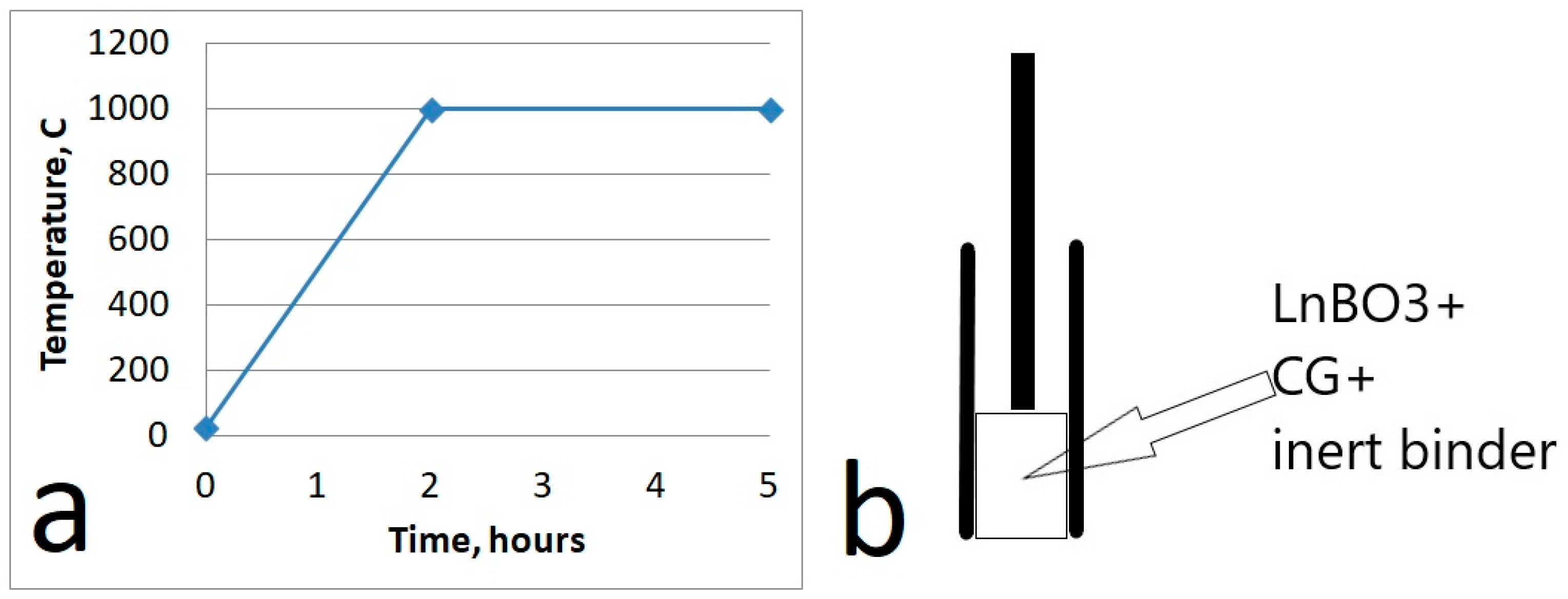
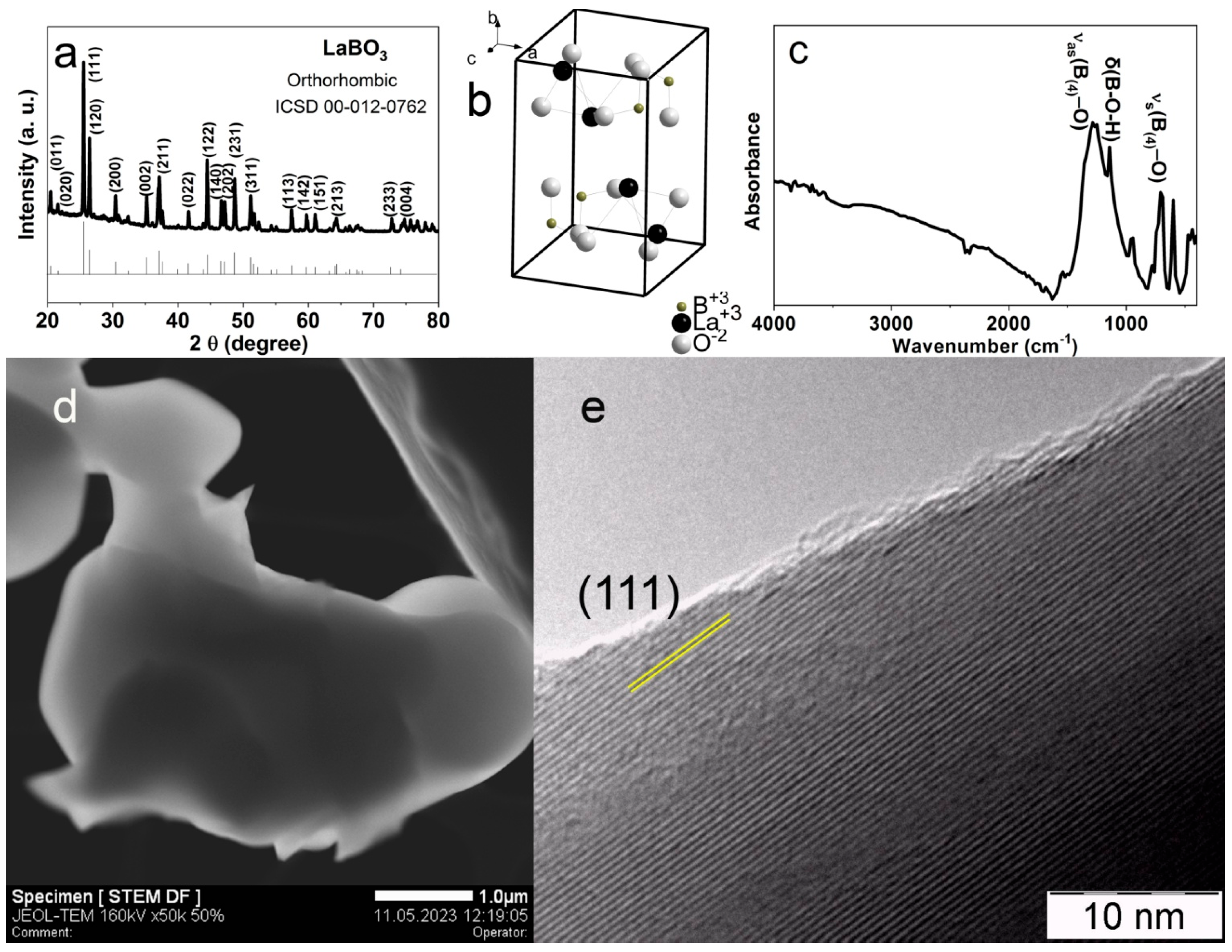
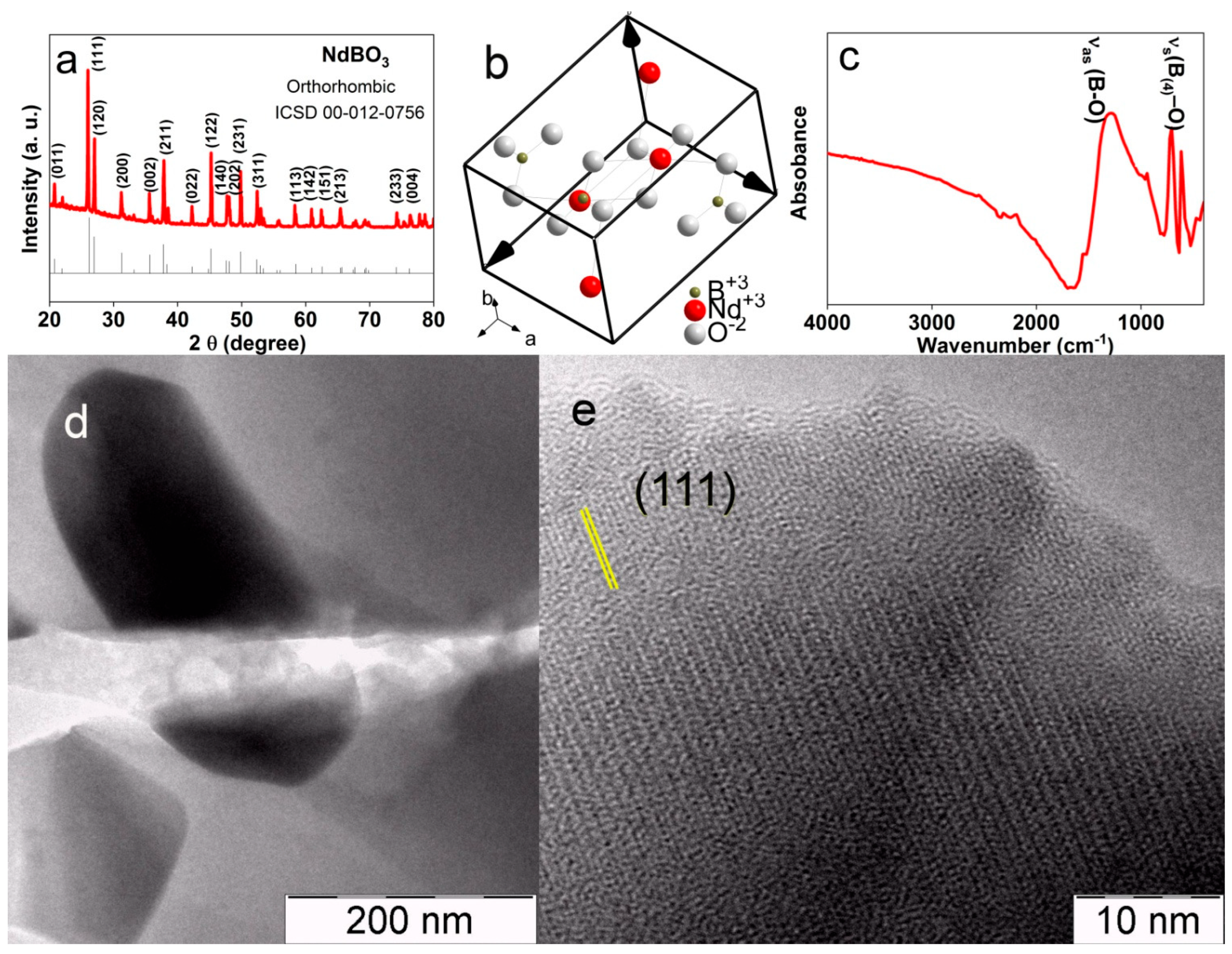
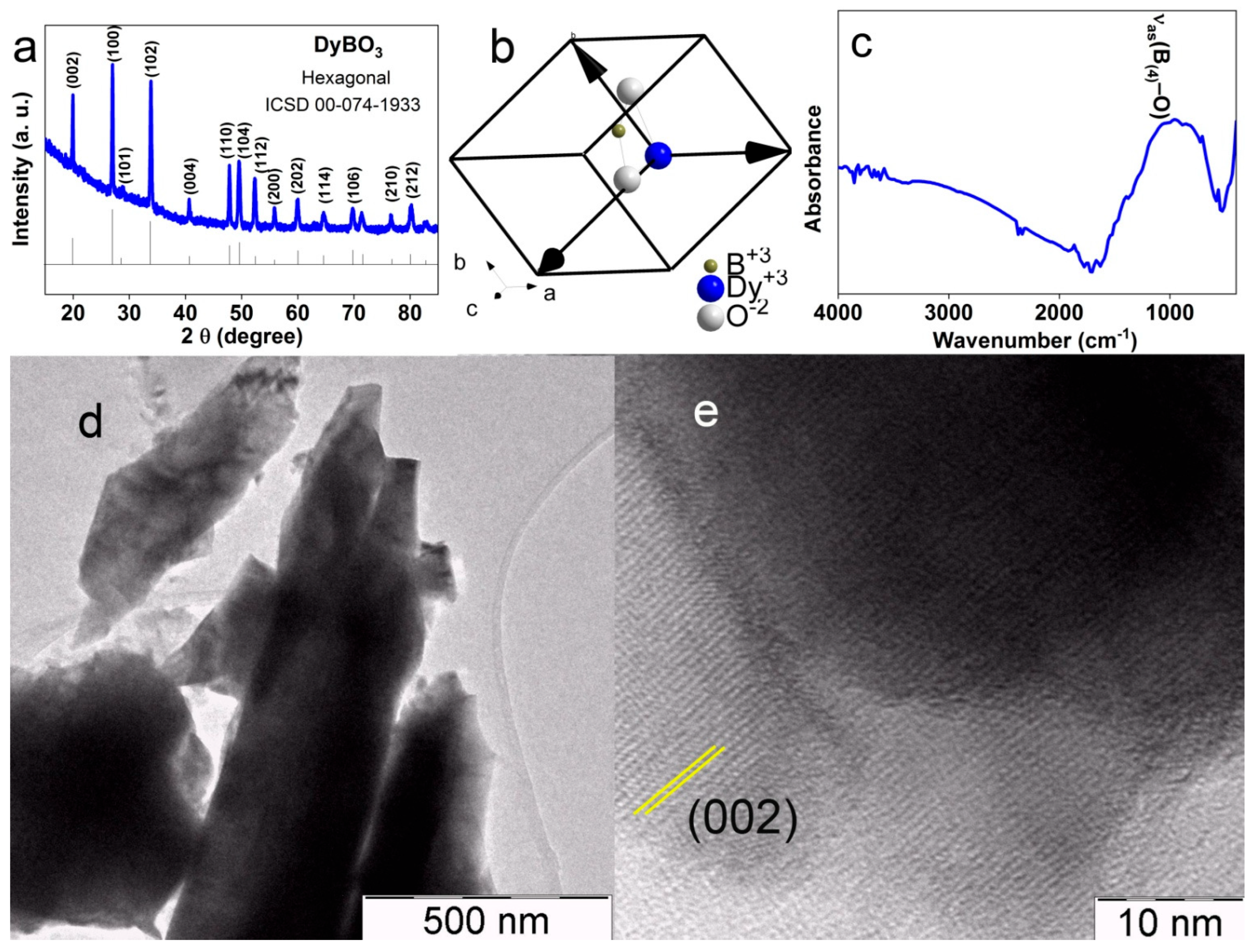

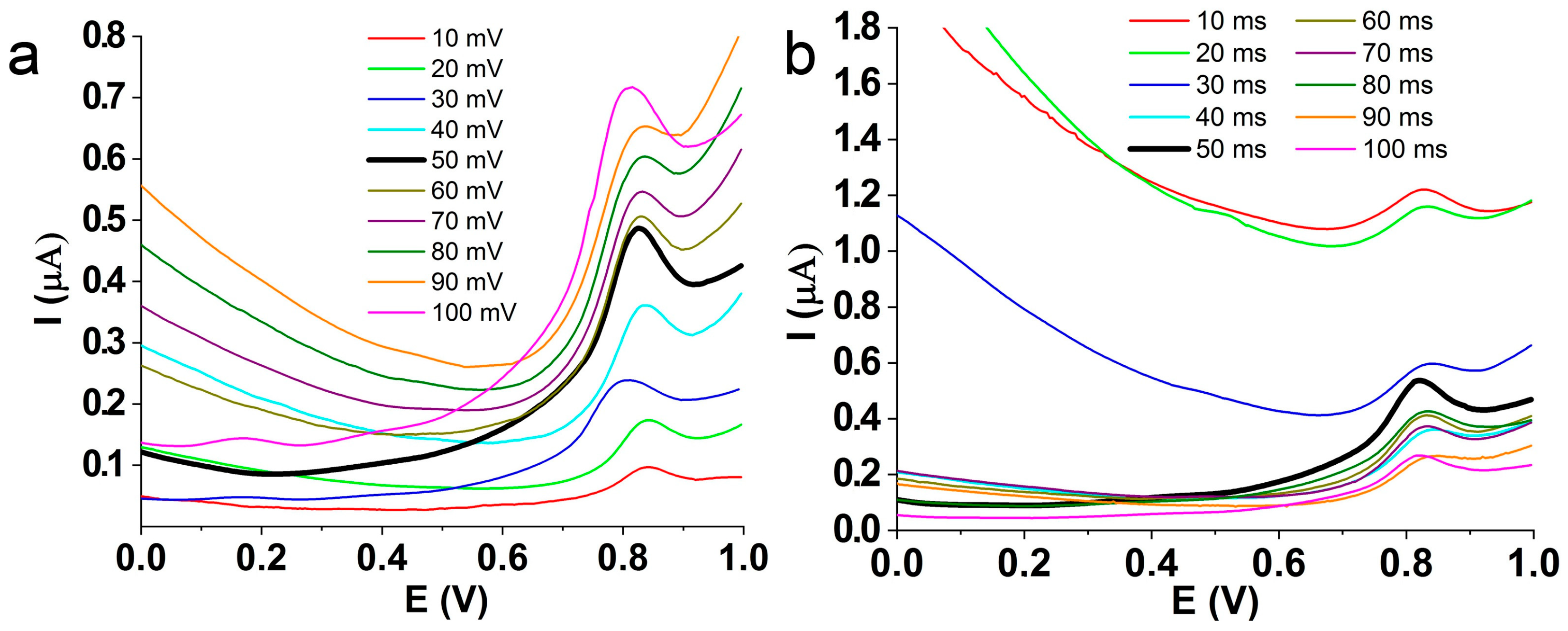
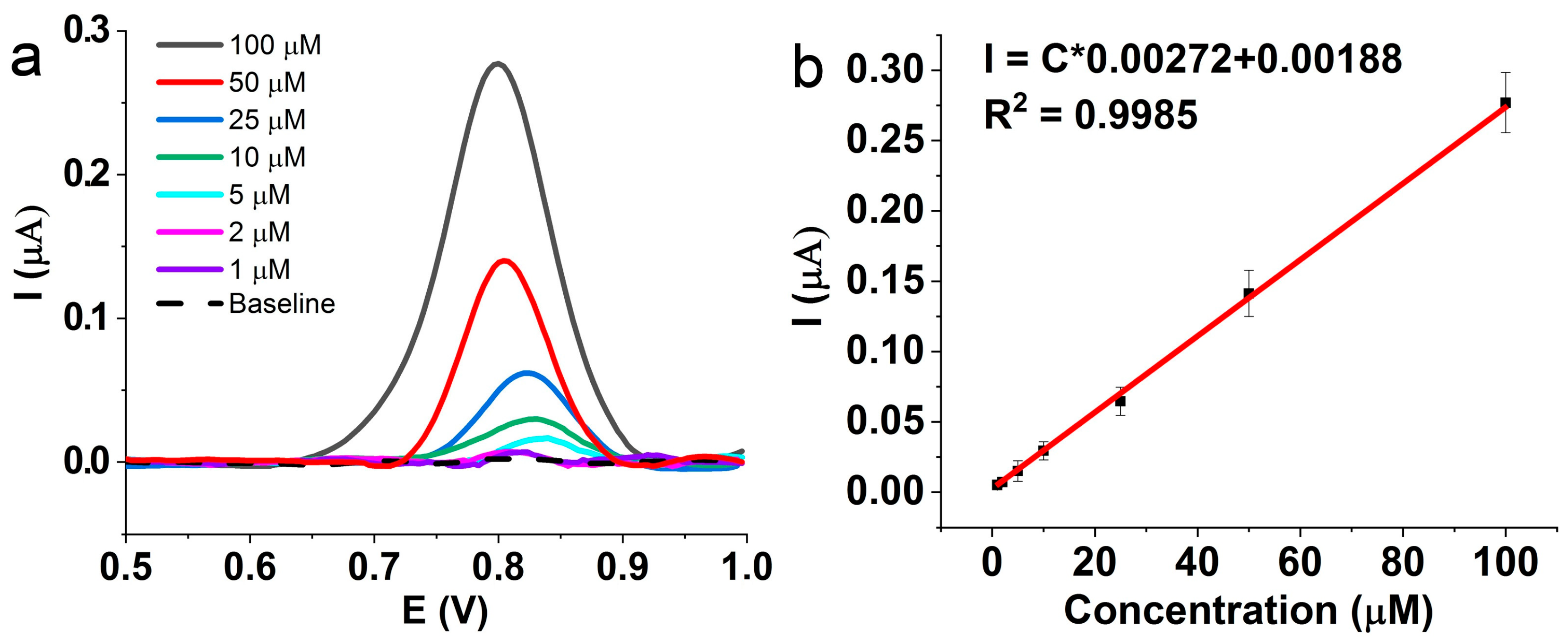
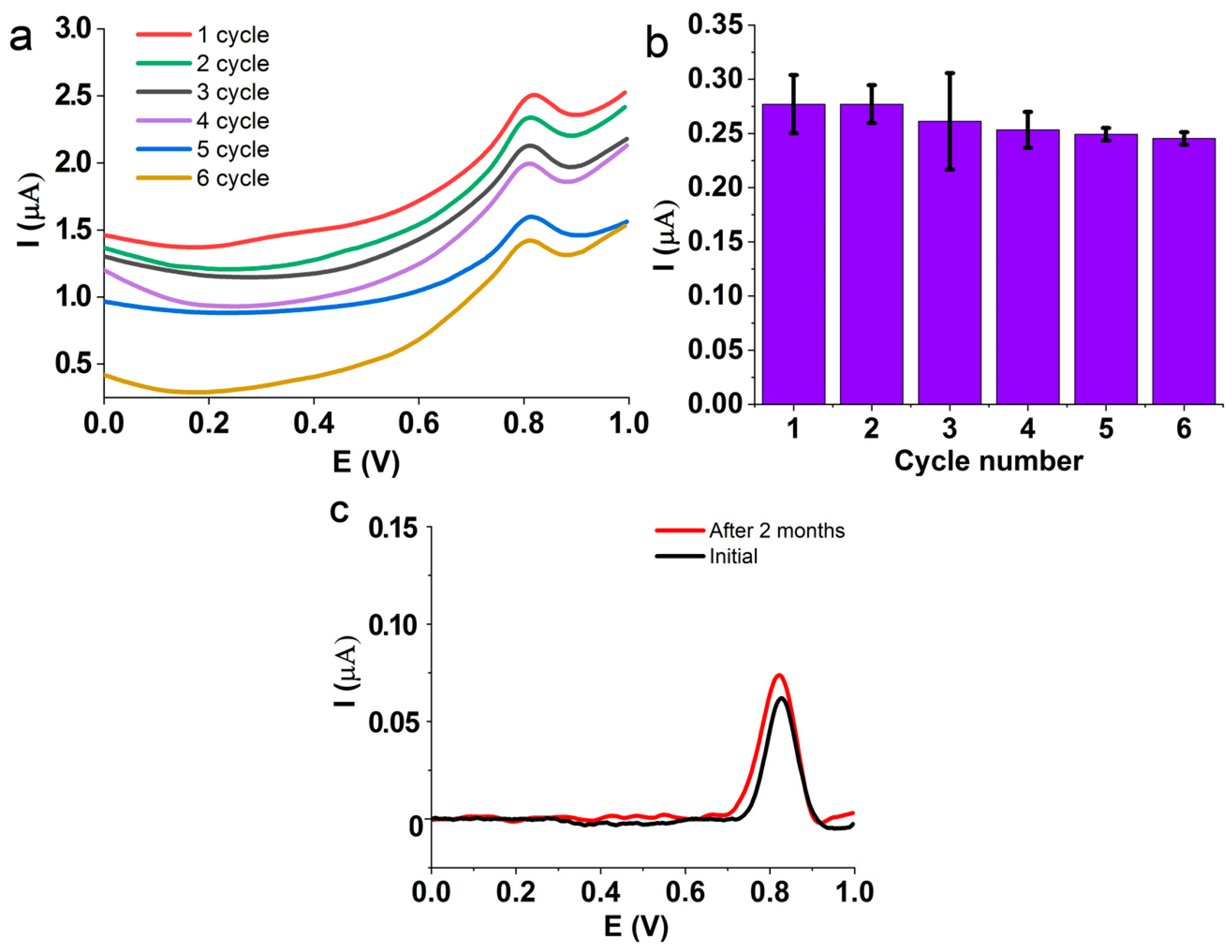
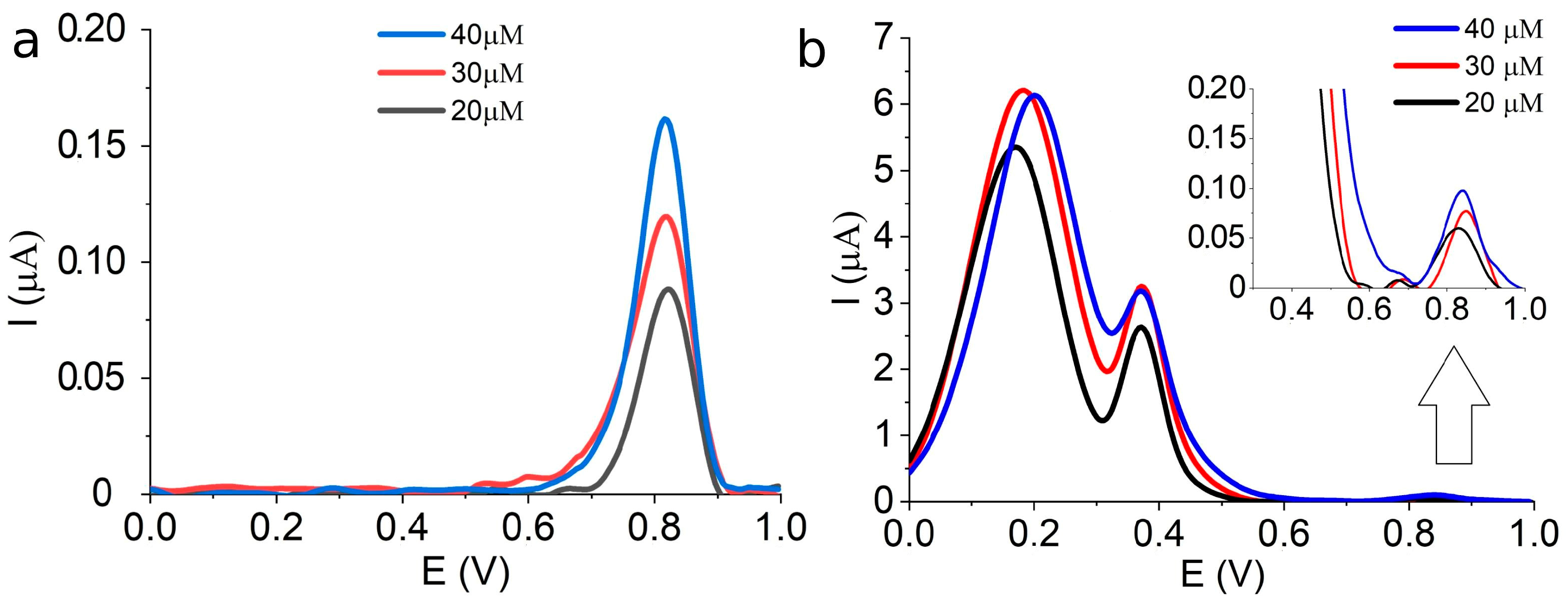
| Materials | a | b | c | α | β | γ | Volume of Cell, (Å3) | Average Crystallite Size (nm) |
|---|---|---|---|---|---|---|---|---|
| LaBO3 | 5.872 | 8.257 | 5.107 | 90.00° | 90.00° | 90.00° | 247.613 | 59.5 |
| NdBO3 | 5.729 | 8.080 | 5.041 | 90.00° | 90.00° | 90.00° | 233.350 | 60.1 |
| DyBO3 | 3.793 | 3.793 | 8.847 | 90.00° | 90.00° | 120.00° | 110.228 | 43.6 |
| Method | Linear Range | LOD | Reference |
|---|---|---|---|
| DPV | 7–47 μM | 3.76 μM | [39] |
| DPV | 8.88–1000 μM | 9.06 μM | [40] |
| DPV | 2–74 μM | 2.5 μM | [43] |
| SW | 200–2000 μM | 29.5 μM | [44] |
| DPV | 1–300 μM | 0.42 μM | [45] |
| DPV | 1–100 μM | 0.051 μM | This work |
| Method | Linear Range | LOD | Reference |
|---|---|---|---|
| Spectrophotometry | 5.9–59 μM | 0.120 μM | [16] |
| Chemiluminecsence | 0.5–2 μM | 0.100 μM | [17] |
| Spectrofluorimetry | 0.6–23.7 μM | 0.440 μM | [18] |
| Liquid chromatography with UV detector | 0.012–35.5 μM | 0.030 μM | [19] |
| DPV | 1–100 μM | 0.051 μM | This work |
Disclaimer/Publisher’s Note: The statements, opinions and data contained in all publications are solely those of the individual author(s) and contributor(s) and not of MDPI and/or the editor(s). MDPI and/or the editor(s) disclaim responsibility for any injury to people or property resulting from any ideas, methods, instructions or products referred to in the content. |
© 2023 by the authors. Licensee MDPI, Basel, Switzerland. This article is an open access article distributed under the terms and conditions of the Creative Commons Attribution (CC BY) license (https://creativecommons.org/licenses/by/4.0/).
Share and Cite
Morozov, R.; Stanković, D.; Avdin, V.; Zherebtsov, D.; Romashov, M.; Selezneva, A.; Uchaev, D.; Senin, A.; Chernukha, A. The Effect of Rare-Earth Elements on the Morphological Aspect of Borate and Electrocatalytic Sensing of Biological Compounds. Biosensors 2023, 13, 901. https://doi.org/10.3390/bios13100901
Morozov R, Stanković D, Avdin V, Zherebtsov D, Romashov M, Selezneva A, Uchaev D, Senin A, Chernukha A. The Effect of Rare-Earth Elements on the Morphological Aspect of Borate and Electrocatalytic Sensing of Biological Compounds. Biosensors. 2023; 13(10):901. https://doi.org/10.3390/bios13100901
Chicago/Turabian StyleMorozov, Roman, Dalibor Stanković, Viacheslav Avdin, Dmitri Zherebtsov, Mikhail Romashov, Anastasia Selezneva, Daniil Uchaev, Anatoly Senin, and Alexander Chernukha. 2023. "The Effect of Rare-Earth Elements on the Morphological Aspect of Borate and Electrocatalytic Sensing of Biological Compounds" Biosensors 13, no. 10: 901. https://doi.org/10.3390/bios13100901
APA StyleMorozov, R., Stanković, D., Avdin, V., Zherebtsov, D., Romashov, M., Selezneva, A., Uchaev, D., Senin, A., & Chernukha, A. (2023). The Effect of Rare-Earth Elements on the Morphological Aspect of Borate and Electrocatalytic Sensing of Biological Compounds. Biosensors, 13(10), 901. https://doi.org/10.3390/bios13100901





